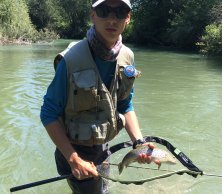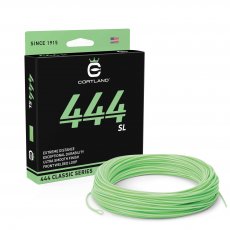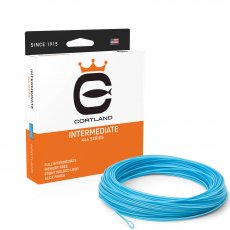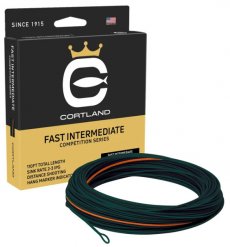A simple recommendation of what fly lines you need for successful fly fishing on European rivers.
For fly fishing, there are many different types of fly lines that you can use for different methods. It is often difficult for a beginner to become familiar with and orientate in all sorts of fly line types, designs and colors. With this article, I would like to help with the selection of the most necessary and most used fly lines for river fly fishing. In the article, I will describe the fly lines from the most necessary ones that you need in the beginning, to the ones that you should get with increasing experience and demands.
At the beginning, I must also mention that for a universal fly rod for smaller streams and rivers in Central Europe, I take a fly rod in aftma 3 in a universal length of 9.3-9.6 feet, or fly rods that have an extension part. Rods with extension are very versatile. In the basic length, without the extension part, the rods are shorter (about 9 feet), which is the ideal length for dry and wet fly fishing. After inserting the extension section, you will extend the rod (10 or more feet) and you have the ideal rod for euro nymphing.
For larger rivers, I take it as a universal fly rod in aftma 4 in the same lengths as with the above-mentioned rods. Again with this equipment you will cover both standard techniques (dry fly, wet fly) - rods in a shorter version, and a Euro nymphing - with longer rods. Even in this aftma category, you can buy a rod with an extension section.
If the main fly fishing discipline will be streamer fishing, then the basic rod is in aftma 5 to 7, 9-10 feet long. With these rods you can cast even bigger and heavier flies, even at a greater distance. Of course, these fly rods can also be used for still water fly fishing.
The most used line, which you cannot do without in your beginnings, is the floating line. You can use it for basic fly fishing techniques, such as dry fly and wet fly and today the already legendary short nymphing (Czech Nymphing). Floating fly lines are produced in a whole range of colors. In addition to more natural colors, such as olive or green, strong colors such as orange or yellow are also common. Many novice fly fishermen fear that distinctive fly lines may frighten fish. In my personal experience, the color of the floating fly line does not affect the fish at all. The advantage of fly line in strong colors is that they are better visible on the water surface, thanks to which you can quickly find out where your fly is.
Nymphing Fly Line (Euronymphing Level Line)
Specialized nymphing fly lines are indispensable for modern nymphing techniques today. Unlike standard fly lines, they have no taper and are extremely thin 0.24-0.55 mm.
When nymphing, the line often just lies in the reel, but when nymphing with a short French or Euro nymph leader (two rod lengths), when we cast the whole leader from the rod, the nymphing line serves as a continuation of the Euro nymph leader, thanks to which we can cast a longer distance. Nowadays, this technique is often variously limited by the fishing regulations, so I recommend purchasing a nymph line and a Euro nymphing leader. This technique in fly fishing is not the most beautiful, but it is undoubtedly very effective.
Due to today's popularity of the French nymphing, I would buy this fly line right from the beginning, because this method of fishing is very effective and, moreover, not so difficult to learn. However, you can also start learning first the short nymph (Czech nymphing), for which a floating fly line is good enough.
We will now move to a slightly heavier caliber in terms of the fly fishing equipment used. We will talk about fly fishing with a streamer, for which intermediate and sinking fly lines are used.
You will also need the following fly line for streamer fishing deeper water.
The slow sinking line is the most used fly line for streamer fishing for me. Thanks to this fly line, you will get to a deeper depth and at the same time you will be able to use lighter or unloaded flies, which work better in the water. Another possible use of the sinking line is for still water fly fishing, where you will most often use it when fishing at great depths.
Sinking fly lines are produced in a different range of sink rate (markings vary by manufacturer). You can use fast sinking lines when streamer fishing on large and deep rivers.
Streamer fishing technique can help you catch a lot of trophy fish and map out where fish are found, especially on large rivers. If you want to start streamer fishing, the sinking fly line must not be missing in your gear. If you specialize only in river fly fishing, get a sinking line for the start (sinking fly line gets priority over the fast intermediate).
Intermediate Fly Line AFTMA 3-4
Now we come to the line, which every fly fisherman definitely doesn't have in his line-up. We are talking about intermediate fly lines in aftma 3 or 4. These fly lines are used for wet fly fishing, when you need to get the flies closer to the bottom, or for active nymphing, where you pull small nymphs. I definitely don't use this fly line as often as I do my floating one, but I like it for a wet fly fishing. I made a lot of success with this line even in winter when fishing for coarse fish on small nymphs on smaller rivers.
The technique of active nymphing is presented in more detail in Lukáš Pazderník's article: Active nymphing.
I recommend purchasing this line to any avid fly-fisher. In your very beginnings, you will definitely do without it, but with increasing experience, however, it can open up new possibilities for fishing for both salmonids and coarse fish.























